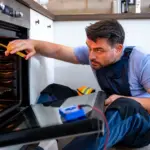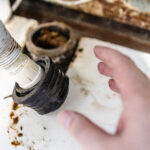Refrigerators are the unsung heroes of our kitchens, quietly keeping our food fresh and drinks cold. But when something goes wrong, it can throw a wrench into our daily routines. From strange noises to puddles on the floor, refrigerator problems are more common than you might think. The good news? Many of these issues can be fixed with a little know-how and some elbow grease. In this blog, we’ll explore the top 10 common refrigerator issues and provide practical solutions to get your appliance humming happily again.
1. Refrigerator Not Cooling Properly
One of the most frequent complaints is a refrigerator that’s not keeping food cold enough. If your milk is spoiling faster than usual, this could be the culprit.
Fix: Start by checking the basics. Ensure the temperature is set between 35°F and 38°F (2°C to 3°C) for the fridge and 0°F (-18°C) for the freezer. Next, inspect the condenser coils—usually located at the back or bottom of the unit. Dust and grime can build up here, reducing efficiency. Unplug the fridge and clean the coils with a vacuum or a coil brush. If the problem persists, the issue might be a faulty evaporator fan or a refrigerant leak, which requires a professional’s touch.
2. Freezer Works, but Fridge Doesn’t
Sometimes the freezer is ice-cold, but the refrigerator section feels more like a pantry. This imbalance can ruin your perishables fast.
Fix: Check the air vents between the freezer and fridge compartments. Blocked vents can prevent cold air from circulating properly. Clear any ice buildup or misplaced items obstructing airflow. Another culprit could be a malfunctioning damper control, which regulates air distribution. If you’re handy, replace it yourself after consulting your manual—or call a technician if it’s beyond your comfort zone.
3. Water Leaking on the Floor
Finding a puddle around your fridge is never a good sign. Leaks can stem from several sources, and ignoring them could lead to bigger headaches.
Fix: First, inspect the defrost drain. Over time, it can clog with debris, causing water to overflow. Locate the drain (often in the freezer floor) and flush it with warm water using a turkey baster. If the leak continues, check the water filter or supply line (if your fridge has an ice maker or dispenser). A cracked line or loose connection might need tightening or replacement.
4. Excessive Frost in the Freezer
A little frost is normal, but if your freezer looks like a winter wonderland, something’s off. This can reduce storage space and strain the appliance.
Fix: For manual-defrost models, unplug the unit and let the ice melt naturally, using towels to soak up water. For frost-free models, excessive buildup suggests a problem with the defrost system—likely the defrost heater, thermostat, or timer. Test these components with a multimeter (after unplugging the fridge) and replace the faulty part. If you’re unsure, a repair pro can handle this.
5. Strange Noises
Is your fridge groaning, buzzing, or clicking like it’s trying to tell you something? Unusual sounds often signal mechanical trouble.
Fix: A low hum is normal, but loud noises aren’t. Rattling could mean the fridge isn’t level—adjust the feet with a wrench until it’s stable. Clicking might indicate a failing compressor relay; if it’s constant, test the relay and replace it if needed. Buzzing or grinding could point to a worn-out evaporator fan. Locate the fan (usually in the freezer), listen for the noise, and swap it out if it’s the source.
6. Ice Maker Not Working
If your ice maker’s on strike, you’re stuck with warm drinks. This is a common issue for fridges with built-in ice dispensers.
Fix: Ensure the ice maker is turned on (check the switch or control arm). A frozen water line could also be the issue—thaw it with a hairdryer on low heat, keeping it a safe distance from plastic parts. If ice still won’t form, the inlet valve or ice maker assembly might be faulty. Test the valve with a multimeter and replace it if it’s not getting power or letting water through.
7. Fridge Running Too Often
A refrigerator that never shuts off can spike your energy bill and wear out the compressor prematurely.
Fix: Dirty condenser coils are often to blame, so clean them as described earlier. Check the door gasket too—a worn or dirty seal lets warm air sneak in, forcing the fridge to work harder. Clean the gasket with warm, soapy water and inspect for cracks; replace it if it’s damaged. If the fridge still runs constantly, the thermostat or compressor might need professional evaluation.
8. Warm Door Edges or Sweaty Walls
If the edges of your fridge doors feel warm or the interior walls are sweating, it might seem alarming—but it’s often fixable.
Fix: Warm edges are usually normal, thanks to built-in heaters that prevent condensation. But if they’re excessively hot, clean the condenser coils to ease the system’s workload. For sweaty walls, check humidity levels in your kitchen and ensure the fridge isn’t overpacked, which restricts airflow. A failing door seal could also let moist air in—test it by closing the door on a dollar bill; if it pulls out easily, replace the gasket.
9. Lights Not Working
Opening the fridge to darkness can be frustrating, especially if the bulb’s not the issue.
Fix: First, replace the bulb with the correct wattage (check your manual). If that doesn’t work, the door switch might be stuck or broken. Locate the switch (usually near the hinge), press it manually, and listen for a click. No click? Unplug the fridge, remove the switch, and test it with a multimeter—replace it if it’s dead. This is a simple fix that can save a service call.
10. Bad Odors
A funky smell wafting from your fridge isn’t a mechanical issue, but it’s a common annoyance that’s easy to tackle.
Fix: Empty the fridge and toss expired or spoiled food. Clean the interior with a mix of baking soda and warm water to neutralize odors—avoid harsh chemicals that can taint food. Check the drip pan beneath the fridge (if accessible) and scrub it clean, as it can harbor smelly buildup. For lingering odors, place an open box of baking soda or activated charcoal inside to absorb them over time.
Final Tips for Refrigerator Health
Preventing these issues starts with regular maintenance. Clean the coils every six months, check door seals yearly, and avoid overloading the fridge to maintain airflow. If a problem feels overwhelming—say, anything involving refrigerant or complex wiring—don’t hesitate to call a certified technician. Safety first!
Your refrigerator works hard to keep your kitchen running smoothly, and with these fixes, you can return the favor. Most of these solutions require minimal tools (a screwdriver, vacuum, and multimeter will cover most bases) and a bit of patience. By addressing issues early, you’ll extend your fridge’s life and keep your groceries safe. Have you run into any of these problems before? Let us know your experience—or your own DIY tips—in the comments below!



